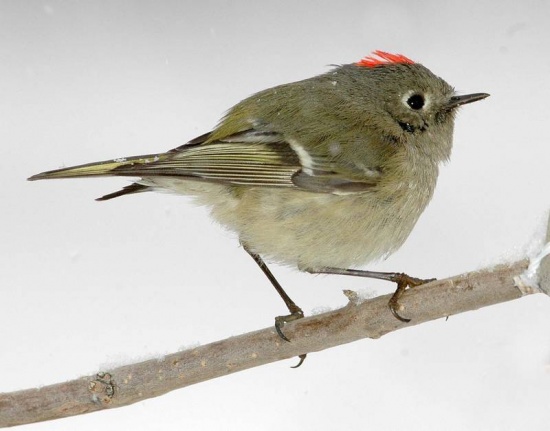- Corthylio calendula
Regulus calendula
Identification
9-11cm. (3-4 inches) A tiny bird with a thin bill, broken eye ring, olive upperparts, pale olive underparts. It has a single major white wing bar with a very minor secondary bar, often indistinct or hidden. Flight feathers and tail have yellow edges. The male has a thin red patch in centre of crown that can be raised (often inobvious or hidden). The most significant diagnostics for identification are the single wing bar, the size, and the frenetic level of activity.
Distribution
Most of North America
- resident in most of Utah and Nevada, as well as Southern Idaho and Northern Arizona
- winters in the southern half of the United States and Mexico
- summers in New England, Canada, and Alaska, as well as parts of Idaho, Wyoming, Colorado, and Montana
- can be seen throughout the rest of the United States when migrating
Taxonomy
This is a polytypic species[1] consisting of 3 subspecies
Subspecies
- C. c. grinnelli - Coastal Alaska and British Columbia; winters to southern California
- C. c. calendula - North and east Canada to northeastern US; winters to Guatemala, Cuba, Bahamas
- C. c. obscurus - Guadalupe Island, off West Mexico.
Habitat
Comon and widespread in coniferous and mixed forests, as well as riparian areas. Highly migratory.
Behaviour
Often travels in small mixed flocks. Forages busily (almost frantically) along branches of trees and bushes. Often in dense brush or thickets. Extremely active, rarely perching for more than a few seconds. Only raises the brilliant ruby crest when excited.
- Diet: The diet includes insects such as moths, beetles, ants, wasps, butterflies, caterpillars, spiders and elderberries and weed seeds. They also drink tree sap and some fruit.
- Breeding: Both sexes build the nest which is a hanging globe shaped cup among twigs of a pine branch. The nest is built of moss and cobwebs and lined with feathers, rootlets and soft bark. The nest can be found in a spruce, firs or pines. 5-11 (usually 7-9) eggs are laid which are white with brown spots. The eggs hatch within 12-13 days and are incubated by the female. The first young leaves the nest approximately 13 days after hatching.
References
- Clements, J. F., T. S. Schulenberg, M. J. Iliff, S. M. Billerman, T. A. Fredericks, J. A. Gerbracht, D. Lepage, B. L. Sullivan, and C. L. Wood. 2021. The eBird/Clements checklist of Birds of the World: v2021. Downloaded from https://www.birds.cornell.edu/clementschecklist/download/
Recommended Citation
- BirdForum Opus contributors. (2025) Ruby-crowned Kinglet. In: BirdForum, the forum for wild birds and birding. Retrieved 11 May 2025 from https://www.birdforum.net/opus/Ruby-crowned_Kinglet
External Links
GSearch checked for 2020 platform.1






